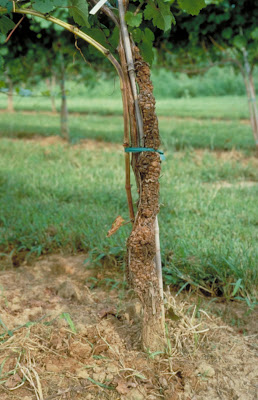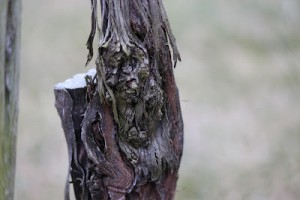Top Tips For Controlling Crown Gall

In extreme cases, crown gall can overwhelm vines or trunks. Severely diseased vines such as this one should be removed immediate Crown gall disease of grape is caused by the bacterium Agrobactgerium vitis (A. tumefaciens biovar 3). Infection and colonization of grape vines by this bacterium are best prevented by cultural practices, which are critical for prevention of crown gall disease.
Crown gall symptoms are characterized by distinct tumor-like overgrowths on roots, trunks, and vines. New galls that form during early summer are light-colored, but they turn dry and corky by late summer. Expansion of galls results in girdling of vines and roots. Suppression of water and nutrient uptake by galls can lead to either rapid vine death or gradual dieback and susceptibility of adverse environmental conditions.
Crown gall bacteria are soilborne, but they survive indefinitely in diseased plants. Infected tissue serves as reservoirs for bacterial cells that can infect other plant parts or healthy plants.
- Practice sanitation, remove all cuttings from vineyards immediately after pruning.
- Remove diseased vines. Remove as much of the rootstock as possible, as bacteria survive for long periods in root fragments.
- Sometimes cutting out diseased wood is effective, but bacteria are systemic (they colonize entire plant vascular systems). Removing all sources of inoculum is highly recommended, but removing entire vines is not always possible. If vines are trained with two trunks, a diseased section can be removed while the other section remains productive.
The crown gall bacterium enters through wounds, such as bark cracks caused by freeze damage. In fact, Vitis vinifera, or French varieties, are most susceptible to cold injury and are therefore most susceptible to crown gall disease.
- Protect graft unions from winter injury. Freeze wounds are the primary sites of entry, and V. vinefera are extremely susceptible to freeze injury.
- Insect wounds are also ideal openings, so control of phylloxera and other insects can reduce numbers of these entry points.
- Beware mechanical damage (string trimmers and other equipment). Again, the crown gall bacterium requires wound sites to enter plant tissue.
- Sanitize pruners after each cut when pruning infected plants. A 10% bleach or 10% Lysol solution in a small bucket makes a great dip.
- Limit overhead irrigation to reduce splash and runoff of any kind.
- Start with clean stock. Use reputable suppliers. This step is critical, especially with V. vinifera.
- Bacterium is systemic and can be transferred from mother plants into cuttings.
- Use certified bacterium-free stock. It is worth the money in the long run.
- V. vinifera are highly susceptible, while table grapes typically show the lowest disease incidence.
- Plant highly susceptible cultivars far away from other plants. Segregating plants is worth the effort in terms of isolating diseased plants and treating diseased ones.
Biological control agents are available for treatment of crown gall. However, they are not a cure that growers should depend upon.
- Agrobacterium radiobacter strain K-84 is effective in reducing galls in vines infected with some species of Agrobacterium, such as A. tumefaciens, but it is not effective against A. vitis. Strain 84 is available as Galltrol A or Norbac 84C and may be used as a pre-plant dip.http://agbiochem.com/Galltrol.aspx
- Products such as Gallex can be applied to existing galls on infected vines (with a paintbrush) in summer or fall to reduce gall formation. http://agbiochem.com/GallEx.aspx. Multiple applications will control, but not cure, crown gall disease.
- Other strains of Agrobacterium, such as A. vitis strain F2/5 will be released soon. It is being examined as a protectant and looks promising.
- Copper fungicides can be good protectants, especially if used often. However, some grape cultivars are sensitive to copper. See Table 14 in the Midwest Grape Production Guide for a listing. http://ohioline.osu.edu/b919/0010.html
This story first appeared in the Spring 2012 Kentucky Vineyard Society Newsletter and is reprinted with permission. Midwest Wine Press is proud to be a member of The Kentucky Vineyard Society which was founded in 1798. Please visit the KVS website at kyvineyardsociety.org.
Nicole Ward Ph.D. is an Associate Extension Plant Pathologist with the University of Kentucky Department of Plant Pathology. She posts often on her blog at nicolewarduk.blogspot.com.




Last night the freezing weather turned out concord grape leaves brown & pods brown and appeared dead. Can these new shoots be pruned back to allow new growth or just let nature run its course.
Thanks
Duane